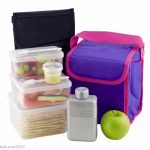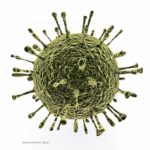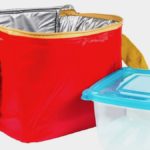Yes it's that time of the year. The USDA is offering parents a guide to food safety for school lunches. There is an inherent risk in packing perishable foods for your child to take to school every day, but with these rules you need to follow you can make sure the food stays safe to eat. USDA Under Secretary for Food Safety Dr. Emilio Esteban said in a statement, "While there have been huge strides in food safety, at least 48 million people in the U.S. are still affected by foodborne illness every year. Our children’s health and safety depend on the safe food handling practices we teach and practice at home." Food safety for school lunches starts in your kitchen. When you prepare food for your child's lunch, and your own too, follow the steps of clean, separate, cook, and chill. … [Read more...]
At Least 130 Sick in Norovirus Outbreak at Las Vegas School
A bout of vomiting last week at the Wayne N. Tanaka Elementary School in Las Vegas, Nevada was caused by norovirus, according to news reports. At least 130 kids were projectile vomiting at this norovirus outbreak at Las Vegas school, according to MSN. The children were sickened during the school day. That quick onset does point to norovirus as the culprit. And that pathogen was confirmed in lab tests a few days ago that were conducted by the Southern Nevada Health District. Norovirus is very contagious and is spread through contaminated food and drink, through contact with surfaces (fomites), and also through person-to-person contact. Symptoms of norovirus include vomiting, nausea, stomach pain, and diarrhea. Some patients may also have fever, headache, and body aches. Most … [Read more...]
It’s Back to School Time! USDA Has Safe Lunch Box Tips
It's back to school time! Many schools are starting in the next couple of weeks. And the USDA has safe lunch box tips to keep your child's lunch healthy and free from pathogens. More than 50,000,000 kids attend schools in the United States. A large percentage of them bring lunches from home. These lunches can be healthy, but if they are made with perishable items such as cooked meats, chicken, cheese, or egg, they must be kept at a safe temperature to prevent illness. For a safe lunch box and bag, start with an insulated lunch bag or box. Brown paper bags are not appropriate for any foods other than whole apples and cookies. The bag should be packed with a frozen gel pack or a frozen juice or drink box or water bottle to make sure that the food is kept out of the danger zone of … [Read more...]
Learn How to Pack a Safe School Lunch For Your Kids
Learn how to pack a safe school lunch this year with tips from Oklahoma State University Extension. While many children get free school lunches, some do prefer to bring a lunch from home. And parents need to be very careful about packing a safe lunch, since children are far more susceptible to serious complications from food poisoning than adults. An improperly packed sack lunch can make kids sick, especially if the food isn't kept cold or hot, out of the danger zone of 40°F to 140°F. Pathogenic bacteria can double in food in 20 minutes while in that temperature range. First, make sure that you purchase a safe lunch box. A double sided insulated box, when packed with a frozen juice box or frozen gel packs, will keep food at a safe temperature for hours. A good thermos should be … [Read more...]
Learn to Prepare Safe Lunches For Back to School By Following Rules
The USDA is helping parents learn to prepare safe lunches for back to school. Many schools are opening next week, so it's time to start planning for what your child will eat. While cafeteria workers take food safety training classes, parents do not. So it's important to learn the basic rules of safe food preparation: Clean, Separate, Cook, and Chill. First, always wash your hands with soap and water before preparing food. Make sure the countertop is clean and that all of your utensils and surfaces are clean. Make sure to remind your children to wash their hands with soap and water before eating. And learn how to wash your hands correctly. Always keep raw meats, poultry, eggs, and seafood away from foods that are eaten raw. Using a separate cutting board for raw meats and … [Read more...]
Back to School Food Safety For Bag Lunches From the USDA
It's back to school time, and that means kids are going to be bringing bag lunches to school. Did you know that if those bags contain perishable foods, they must be handled and stored properly? The USDA has tips to help you keep your child safe. Harmful bacteria, such as Salmonella, E. coli, and Listeria monocytogenes, multiply quickly in the Danger Zone temperature range of 40 °F and 140°F; that includes room temperature. Perishable foods that are held without an ice source, or without refrigeration, won't stay safe to eat for long. So here's what to do. First, all perishable foods, such as meat, poultry, fish, and eggs, must be kept cold at all times. When you're at the store, buy those foods last, go home immediately, and refrigerate them immediately. No perishable … [Read more...]
Back to School Meal Prep and Food Safety From Uncle Sam
Most schools in the United States start next Tuesday, after Labor Day. That prospect can be daunting for parents who provide lunches and snacks for their kids to tote to school, but Uncle Sam has some advice about making back to school meal prep easy. First, it's important to plan out the menu for the week. Look for recipes you know your kids will like, then create a shopping list based on the foods you need. Make sure, at the store, that you put any refrigerated or frozen foods into the cart last, just before you check out. And those items must be put in the refrigerator or freezer within two hours after you finish shopping. Safe food preparation is next on the checklist for back to school lunches. Make sure that your kitchen is clean before you start to cook and prepare foods. … [Read more...]
Back to School Food Safety Tips
It's almost time for the new school year to begin. As parents start to prepare, it's important to consider back to school food safety if you pack lunches or snacks for your child. The government is offering tips on keeping your children safe from foodborne illness. It's important that you always use an insulated carrier to pack the food your child takes to school. If the lunch or snack contains a perishable food such as meat, eggs, cheese, or yogurt, always use at least two cold sources in the insulated carrier. You can use commercial freezer packs, frozen juice boxes, or frozen water containers. The last two will thaw in time for lunch while it keeps the temperature in the carrier below 40°F. Never use a paper bag to pack lunches or snacks for your child. Perishable cold foods … [Read more...]
Packed Lunch Food Safety
As the new school year gets underway, parents need to know how to pack lunches safely. Food poisoning can be very serious for young children, so their food needs to be as safe as possible. The FDA has more information about safe bag lunches. Know that all perishable foods, including meat, poultry, seafood, dairy products, and eggs, should be kept cold at all times. Any of these foods should not be left at room temperature longer than 2 hours - 1 hour if the air temperature is over 90°F. Wash your hands well with soap and water for at least 20 seconds before you start to prepare the food and pack the lunch. Sanitize a lunch box that hasn't been used in a while by wiping it with a solution of 1 tablespoon liquid chlorine, unscented bleach in 1 gallon of water. Advance planning … [Read more...]
Back to School Food Safety
With everyone getting ready to go back to school, there are some steps you can take to make sure your child's lunch is safe. Foodsafety.gov is offering some tips to consumers. When you buy a lunch box, make sure that it is insulated, with enough room for two cold sources to keep the food safe. Perishable foods must be kept below 40°F to prevent bacterial growth. Make sure that the lunch box is easy to clean. Always wash all reusable food storage containers with hot, soapy water after each use. Thermoses should be tested before use to make sure they can keep hot foods hot and cold foods cold. Fill it with hot water and let the thermos stand at room temperature for 4 to 6 hours. Then test the water with a reliable food thermometer and make sure it is at least 140°F, the safe … [Read more...]








